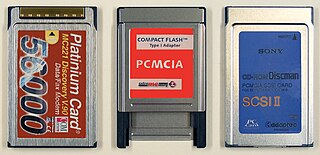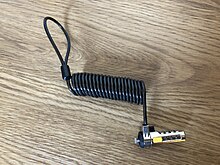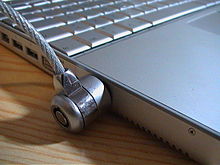
PC Card is a parallel peripheral interface for laptop computers and PDAs. The PCMCIA originally introduced the 16-bit ISA-based PCMCIA Card in 1990, but renamed it to PC Card in March 1995 to avoid confusion with the name of the organization. The CardBus PC Card was introduced as a 32-bit version of the original PC Card, based on the PCI specification. The card slots are backward compatible for the original 16-bit card, older slots are not forward compatible with newer cards.

A laptop computer or notebook computer, also known as a laptop or notebook, is a small, portable personal computer (PC). Laptops typically have a clamshell form factor with a flat-panel screen on the inside of the upper lid and an alphanumeric keyboard and pointing device on the inside of the lower lid. Most of the computer's internal hardware is fitted inside the lower lid enclosure under the keyboard, although many modern laptops have a built-in webcam at the top of the screen, and some even feature a touchscreen display. In most cases, unlike tablet computers which run on mobile operating systems, laptops tend to run on desktop operating systems, which were originally developed for desktop computers.

A lock is a mechanical or electronic fastening device that is released by a physical object, by supplying secret information, by a combination thereof, or it may only be able to be opened from one side, such as a door chain.
Laptop theft is a significant threat to users of laptop computers. Many methods to protect the data and to prevent theft have been developed, including alarms, laptop locks, and visual deterrents such as stickers or labels. Victims of laptop theft can lose hardware, software, and essential data that has not been backed up. Thieves also may have access to sensitive data and personal information. Some systems authorize access based on credentials stored on the laptop including MAC addresses, web cookies, cryptographic keys and stored passwords.

A safe is a secure lockable enclosure used for securing valuable objects against theft or fire. A safe is usually a hollow cuboid or cylinder, with one face being removable or hinged to form a door. The body and door may be cast from metal or formed out of plastic through blow molding. Bank teller safes typically are secured to the counter, have a slit opening for dropping valuables into the safe without opening it, and a time-delay combination lock to foil thieves. One significant distinction between types of safes is whether the safe is secured to a wall or structure or if it can be moved around.

In computing, a docking station, port replicator (hub), or dock provides a simplified way to plug-in a mobile device, such as connect common peripherals to a laptop, or charge a smartphone. Because a wide range of dockable devices—from mobile phones to wireless mouse—have different connectors, power signaling, and uses, docks are unstandardized and are therefore often designed for a specific type of device.

A bicycle lock is a security device used to deter bicycle theft, either by simply locking one of the wheels or by fastening the bicycle to a fixed object, e.g., a bike rack.

Padlocks are portable locks usually with a shackle that may be passed through an opening to prevent use, theft, vandalism or harm.

A safety wire or locking-wire is a type of positive locking device that prevents fasteners from falling out due to vibration and other forces. The presence of safety wiring may also serve to indicate that the fasteners have been properly tightened.
Outbound Systems, Inc., was an American computer company based in Boulder, Colorado. Founded by Warren Conner in 1989, the company offered Macintosh clone computer systems in various portable form factors between 1989 and 1991. It left the Mac conversion business in 1992 to build Windows-based desktop computers before going bankrupt in 1993.
Slot, the slot or Slots may refer to:
Physical information security is the intersection or common ground between physical security and information security. It primarily concerns the protection of tangible information-related assets such as computer systems and storage media against physical, real-world threats such as unauthorized physical access, theft, fire and flood. It typically involves physical controls such as protective barriers and locks, uninterruptible power supplies, and shredders. Information security controls in the physical domain complement those in the logical domain, and procedural or administrative controls.

A surfboard lock is a device or a mechanism for securing a surfboard to prevent theft or loss. Typically surfboard locks attach to some part of the surfboard, such as the leash plug or center fin box slot. Alternately, some locking devices clamp or strap around the surfboard. Once the board is secured, the locking device attaches to some hard point like a vehicle or a non-movable object.

A chain is a serial assembly of connected pieces, called links, typically made of metal, with an overall character similar to that of a rope in that it is flexible and curved in compression but linear, rigid, and load-bearing in tension. A chain may consist of two or more links. Chains can be classified by their design, which can be dictated by their use:

Three-point locking, or a multipoint lock, is a locking system installed in cabinet or locker doors to enable more secure locking. Whereas in single-point locking, the door on a cabinet locks only at the point where the key is turned, halfway up the edge of the door, three-point locking enables the top and bottom of the door to be simultaneously secured. This is accomplished by attaching two long steel rods to the lock on the inside of the door, which extend vertically upwards and downwards: when the lock is turned, the rotary movement of the latch on the inside of the door translates to vertical movement in these rods, with the result that the upper rod moves upwards by an inch or so, and the lower rod moves downwards similarly. This causes the ends of the rods to move through small holes in the flanges at the top and bottom of the door, resulting from the metal of the door being turned inwards, and the rods then move a short distance into holes in the metal surrounding the door. This effectively immobilizes the top and bottom of the door, and greatly increases the security of the door-locking compared to a door with only single-point locking.

Security seals are tamper-evident mechanisms that seal valuable material in a room, cabinet, vehicle, or other storage facility. One common use is to seal cargo in transit shipping containers in a way that provides tamper evidence and some level of rudimentary security. Such seals can help to detect theft or contamination, either accidental or deliberate. Security seals are commonly used to secure truck trailers, vessel containers, chemical drums, airline duty-free trolleys, keys and utility meters. Typically they are considered an inexpensive way of providing tamper evidence of intrusion into sensitive spaces.
A computer lock is a physical lock on a computer with an accompanying key used for access control or as an anti-theft system.

A bolt snap is a type of snap hook with a manually operated bolt action slide gate of medium security used to clip a light load to a ring, eye, loop or bight to temporarily secure or suspend an object. They are used for a wide variety of applications including dog leads and for clipping scuba equipment to the diving harness. A similar but more secure device used to attach sails to a stay is known as a piston hank. It differs from a snap shackle in that the load is not carried by the gate. The bolt snap must be actively operated by the user to clip or unclip, and is not easily snagged or unintentionally clipped or unclipped by pressing or bumping against the surroundings.
Maclocks are a line of computer security lock and display products that focuses on security for Apple products. The brand was first released in 1986 and is manufactured by Compulocks.

Kensington Computer Products Group is an American manufacturer of personal computer peripherals. The company produces peripherals including docking stations, mice, and the eponymous Kensington Lock security cable. Headquartered in Burlingame, California, Kensington is a division of ACCO Brands.

















